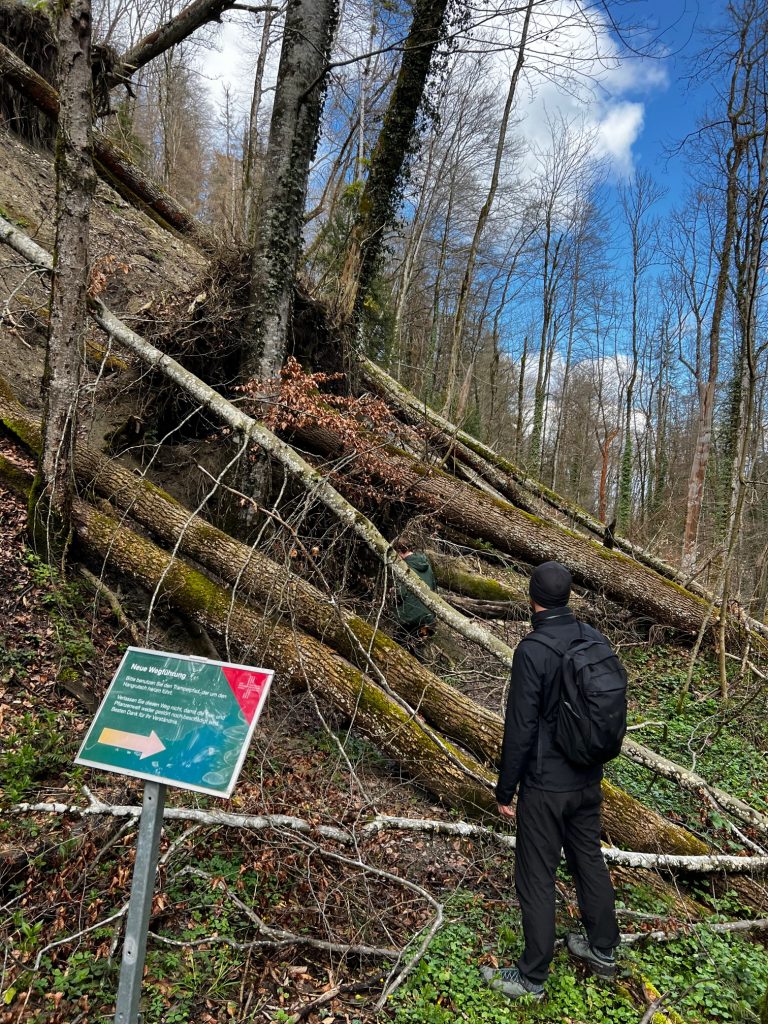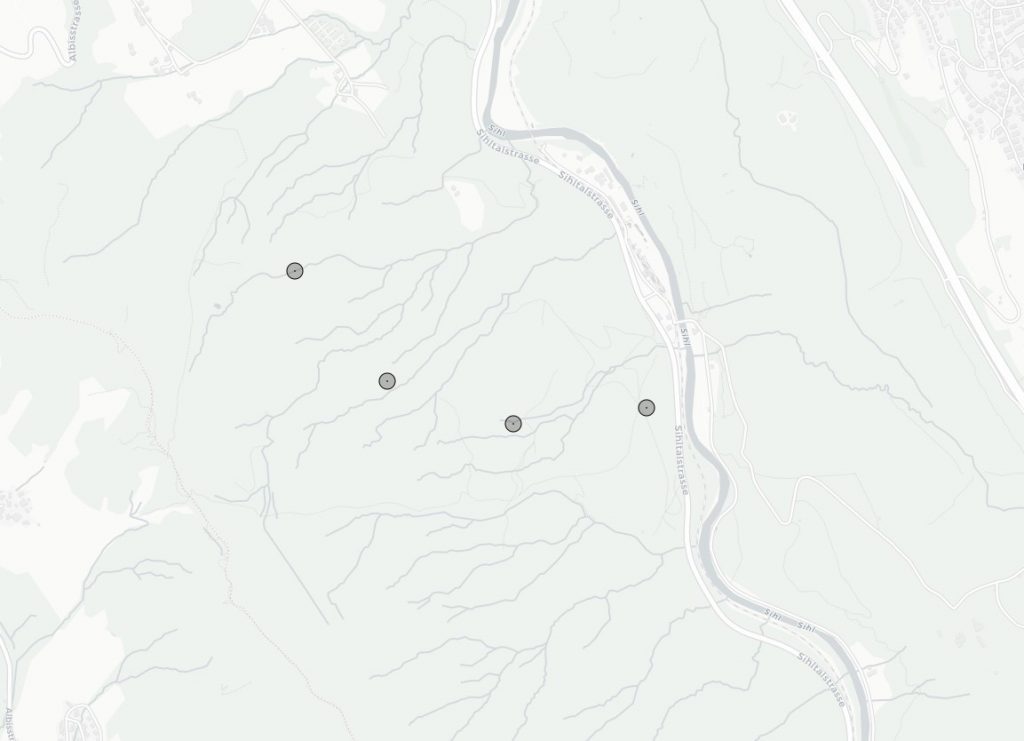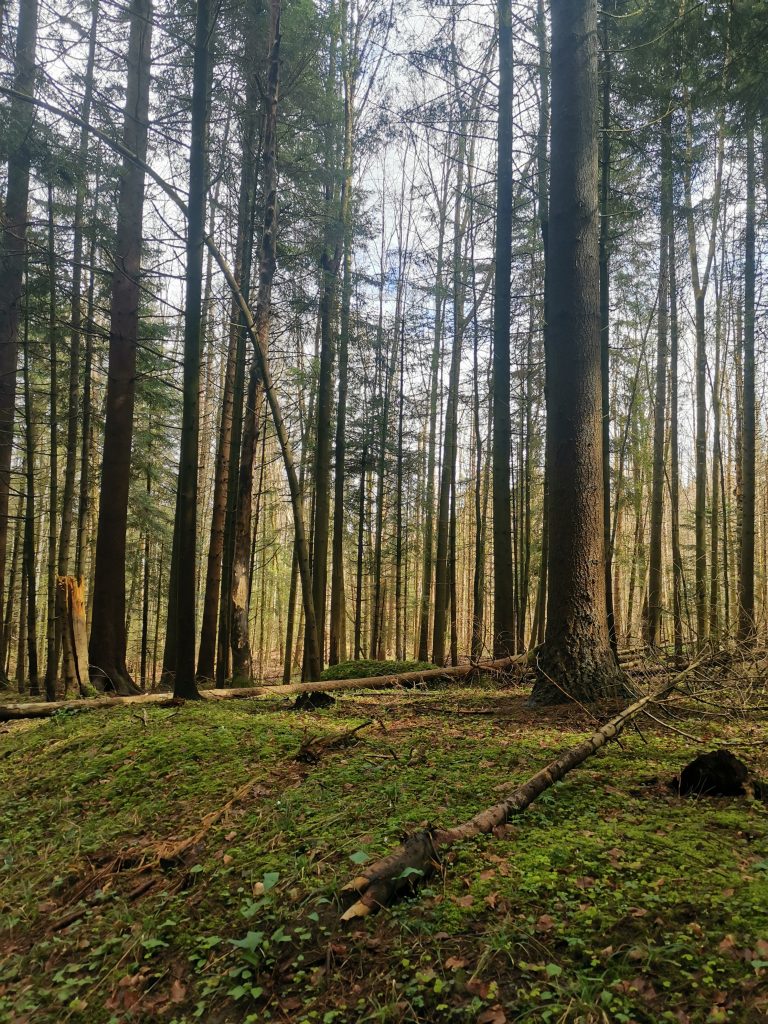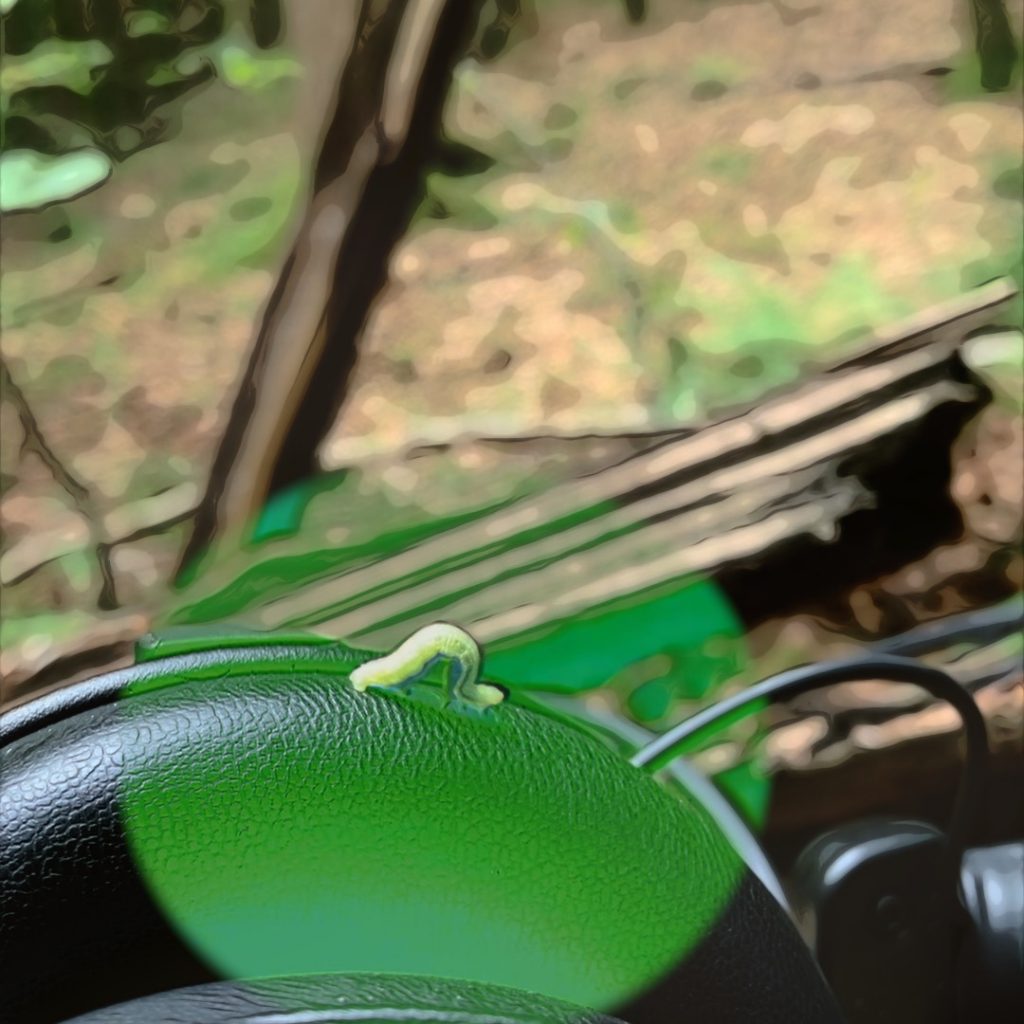Welcome to the environmetal listening session #8. The students of the Sound & Environment 2023 spring semester’s course at ZHdK worked again at Sihlwald, a natural reserve at the border of the city of Zurich. The soundmap has been extended and new works have been created.

Sound map

Once you have navigated to the map, please load a map or satellite image from the top right menu and navigate to Zurich. In the south at the Sihl river lies the Sihlwald – click on the corresponding point in the map and listen to our field recordings.
We would like to express our sincere thanks for the support and scientific assistance to Ronald Schmidt at Wildnispark Sihwald and Elena Haeler at WSL Birmensdorf.
Works

Locus Amoenus, in latin “pleasant place”, is a literary topos that describes an idyllic place, generally in the nature, that connects with the feelings of the poet. From the Roman Empire times until the 16th century, it was considered a nuclear motif for nature descriptions. The locus amoenus was introduced in Spanish literature thanks to the writer from the Renaissance Garcilaso de la Vega, whos main inspiration were the poems by classic Italian poet Francesco Petrarca.
The locus amoenus has changed through history, going from the bucolic idealism of the Renaissance, the shadows and wildness of the Romanticism to the urban spaces in the 19th Century. It is a timeless topos in the literature.
I chose a poem by Spanish poet from the 20th Century Antonio Machado. It belongs to his work Soledades; a collection of poems from 1903, whose main topics were the loneliness, the course of time and the searching of happiness and identity. All of this topics are presented in Hacia un ocaso radiante, the XIII poem of Soledades¸ all presented under the locus amoenus, that is, describing elements of the nature (the sky, the trees, the birds, the water…) that match with the poet’s soul and feelings.
Locus Amoenus is for me a simple experiment with my voice. The idea was to create a big contrast between the nature sounds and the most altered sounds of the voice, which is also the most natural instrument. My willing was make the words and sounds more and more incomprehensible as the repetition of the poem goes on, adding filters, layers of voices, changing the speed… Nevertheless, the sound of then nature keeps unaltered.
In the personal aspect, this piece is a metaphor to illustrate how I can deal with overthinking, how my thoughts become more and more blurry while everything keeps quiet.
The original poem and its translation follows behind:
XIII
Hacia un ocaso radiante
caminaba el sol de estío,
y era entre nubes de fuego, una trompeta gigante
tras de los álamos verdes de las márgenes del río.
Dentro de un olmo sonaba la sempiterna tijera
de la cigarra cantora, el monorritmo jovial,
entre metal y madera,
que es la canción estival.
En una huerta sombría
giraban los cangilones de la noria soñolienta.
Bajo las ramas obscuras el son del agua se oía.
Era una tarde de julio, luminosa y polvorienta.
Yo iba haciendo mi camino,
absorto en el solitario crepúsculo campesino.
Y pensaba: «¡Hermosa tarde, nota de la lira inmensa,
toda desdén y armonía;
hermosa tarde, tú curas la pobre melancolía
de este rincón vanidoso, obscuro rincón que piensa!».
Pasaba el agua rizada bajo los ojos del puente.
Lejos, la ciudad dormía
como cubierta de un mago fanal de oro transparente.
Bajo los arcos de piedra el agua clara corría.
Los últimos arreboles coronaban las colinas,
manchadas de olivos grises y de negruzcas encinas.
Yo caminaba cansado,
sintiendo la vieja angustia que hace el corazón pesado.
El agua en sombra pasaba tan melancólicamente,
bajo los arcos del puente,
como si al pasar dijera:
«Apenas desamarrada
a pobre barca, viajero, del árbol de la ribera,
se canta: no somos nada.
Donde acaba el pobre río la inmensa mar nos espera».
Bajo los ojos del puente pasaba el agua sombría.
(Yo pensaba: ¡el alma mía!)
Y me detuve un momento,
en la tarde, a meditar…
¿Qué es esta gota en el viento
que gritar al mar: soy el mar?
Vibraba el aire asordado
por los élitros cantores que hacen el campo sonoro,
cual si estuviera sembrado
de campanitas de oro.
En el azul fulguraba
un lucero diamantino.
Cálido viento soplaba
alborotando el camino.
Yo, en la tarde polvorienta,
hacia la ciudad volvía.
Sonaban los cangilones de la noria soñolienta.
Bajo las ramas obscuras caer el agua se oía.
(English translation) XIII
The summer sun was traveling
toward a radiant sunset,
through fiery clouds it was a giant trumpet
behind the green poplars on the riverbank.
In the elm tree echoed the eternal scissors
of the cicada’s song, the cheerful mono-rhythm,
a sound of wood and metal
that is the song of summer.
In a shady garden
the buckets of the sleepy water-wheel were turning.
Under dark branches the sound of the water was heard.
It was a dusty and luminous afternoon in July.
I was traveling along,
enjoying the solitary rustic twilight.
And I thought: “Beautiful afternoon, note of the immense lyre,
full of disdain and harmony;
beautiful afternoon, you heal the poor melancholy
of this vain corner of life, an obscure corner that thinks!”
The rippling water passed under the arches of the bridge.
In the distance, the city was sleeping
like the cover of a magic lantern of transparent gold.
Under the stone arches the water was flowing.
The last splashes of red crowned the hills
filled with grey olive trees and blackish oaks.
I was traveling wearily,
feeling that old anguish that weighs on my heart.
In the shadows the water flowed so sadly
under the arches of the bridge,
as if in passing it was saying:
“Traveler, soon after your poor ship
has been untied from the tree on the riverside
it sings out: we are nothing.
Where the river ends, the immense sea waits for us.”
Under the arch of the bridge the dark water was flowing.
(I thought: like my soul!)
And I stopped for a moment,
in the late afternoon, to meditate…
What is this drop in the wind
that shouts to the sea: I am the sea?
The air vibrated, dampened
by the singing insects that fill the land with sound,
as if it were scattered
with little golden bells.
Sparkling in the blue,
a diamantine morning star.
A gust of hot wind
stirring up the road.
In the dusty afternoon,
I turned back toward the city.
The buckets of the sleepy water-wheel rattled.
Beneath dark branches the sound of falling water.

The project 13 of 23 was created as part of the module Sound and Environment with Marcus Maeder in the spring semester 2023 at the Zurich University of the Arts ZHdK.
Hourly five-minute sound recordings between 05 – 23 o’clock over 23 days resulted in an audible, interesting smorgasbord of sonic impressions from the Sihlwald near Zurich.
These sound recordings were visualized with the help of software, which simplified the localization of specific sounds. Based on these visualizations, patterns or specific bird species could be read out. Thus, birds whose calls might be suitable for data sonification were specifically sought.
These selected bird calls were used in the sonification of growth, temperature, moisture, and water potential data. The data originated from trees in the Sihlwald and were read from the Treenet database of the WSL, from the period April 17-22.
This resulted in a 5 minute listening impression from 23 days, i.e. 13 seconds per day can be heard. In addition, the recording time shifts daily by 1h and 13 seconds backwards, whereby a whole daily routine from the Sihlwald is shown.
The now audible data of the trees from the Sihlwald were added to these excerpts, each lasting 13 seconds.
“WOODSCAPE” is a speculative project that explores the idea of retreat and relaxation into nature through an immersive soundscape. Sound recordings collected with the help of special wildlife recorders in the recreation area Sihlwald near Zurich serve as a basis. To convey the nature recordings, a helmet was constructed which, through integrated headphones, enables a special sound experience that is timed to the events in the forest. Through the use of natural elements of the forest, such as moss and ivy, which encase the helmet, not only the sense of hearing but also the sense of smell and touch are stimulated. This creates the feeling of being in the middle of the forest, experiencing different nuances of sound and moods, be it the lively morning hour or the quiet atmosphere of the night. “WOODSCAPE” allows you to escape from the noisy and hectic everyday life and find a moment of relaxation to connect with the natural environment without being physically present.

A dead tree winds across the hill, as if a snake were lying in the forest. Firmness in the woodworm. Our imagination does not die when we look at the mound of trees. Only dirt! Who would have ever thought that dead trees have a long life before they grow back into the earth. Or can we even call it living if it is dead after all? Leaving dead wood standing so the forest lives on. The sonic investigation of dead wood in the Siehlwald Nature Experience Park, as well as the investigation of a decomposed tree in the form of a mound, led to a free sound experiment: How do we imagine the sonic transformation of a decaying tree in sonic time-lapse? A field recording trip to the Sihlwald generated the sound material. The dead tree and the decaying tree in the form of a mound acted as sound sources. Various microphones, coming together in a multitrack recording, captured our interaction with these forest formations. A new structure was composed from the material. Our own forest structure.
I overheard the birds
While I wasn’t present.
Now I am playing their singing
and connect two places.
The birds don’t care.
I can use my fingertips to jump
through time and space.
2 audio recordings at the same time in different places. Graphite, cardboard, capacitive sensors, Speakers, mini controllers.
Michèle Scaramuzza: Sihwaldklangbilder
Afterimages of field recordings from Sihlwald April 2023, selection of 483 files
During three weeks, every hour, for five minutes, I collected sound data in the Sihlwald; field recordings.
In the studio I listen to the sound and draw, paint what I hear and what seems important to me. The five minutes give me the exact limit of how long I work on a recording.
It is an attempt to describe and transform acoustic information into aesthetic sensory perception. Scores are created, with the attempt to describe simultaneity linearly without being able to do so. I, as a phonographer, decide what to record and what not to record.